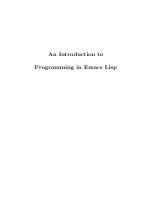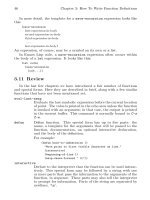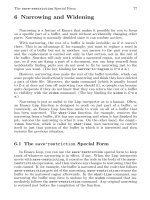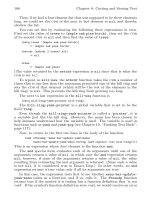An introduction to R Graphics Data Visualization in R
Bạn đang xem bản rút gọn của tài liệu. Xem và tải ngay bản đầy đủ của tài liệu tại đây (3.43 MB, 62 trang )
Data Visualization in R
1. Overview
Michael Friendly
SCS Short Course
Sep/Oct, 2018
/>
Course outline
1.
2.
3.
4.
Overview of R graphics
Standard graphics in R
Grid & lattice graphics
ggplot2
Outline: Session 1
• Session 1: Overview of R graphics, the big picture
Getting started: R, R Studio, R package tools
Roles of graphics in data analysis
• Exploration, analysis, presentation
What can I do with R graphics?
• Anything you can think of!
• Standard data graphs, maps, dynamic, interactive graphics –
we’ll see a sampler of these
• R packages: many application-specific graphs
Reproducible analysis and reporting
• knitr, R markdown
• R Studio
-#-
Outline: Session 2
• Session 2: Standard graphics in R
R object-oriented design
Tweaking graphs: control graphic parameters
• Colors, point symbols, line styles
• Labels and titles
Annotating graphs
• Add fitted lines, confidence envelopes
Outline: Session 3
• Session 3: Grid & lattice graphics
Another, more powerful “graphics engine”
All standard plots, with more pleasing defaults
Easily compose collections (“small multiples”)
from subsets of data
vcd and vcdExtra packages: mosaic plots and
others for categorical data
Lecture notes for this session are available on the web page
Outline: Session 4
• Session 4: ggplot2
Most powerful approach to statistical graphs,
based on the “Grammar of Graphics”
A graphics language, composed of layers, “geoms”
(points, lines, regions), each with graphical
“aesthetics” (color, size, shape)
part of a workflow for “tidy” data manipulation
and graphics
Resources: Books
Paul Murrell, R Graphics, 2nd Ed.
Covers everything: traditional (base) graphics, lattice, ggplot2, grid graphics, maps, network diagrams, …
R code for all figures: />
Winston Chang, R Graphics Cookbook: Practical Recipes for Visualizing Data
Cookbook format, covering common graphing tasks; the main focus is on ggplot2
R code from book: />Download from: />
Deepayn Sarkar, Lattice: Multivariate Visualization with R
R code for all figures: />
Hadley Wickham, ggplot2: Elegant graphics for data analysis, 2nd Ed.
1st Ed: Online, />ggplot2 Quick Reference: />Complete ggplot2 documentation: />
7
Resources: cheat sheets
R Studio provides a variety of handy cheat sheets for aspects of data analysis &
graphics See: />
Download, laminate,
paste them on your
fridge
8
Getting started: Tools
• To profit best from this course, you need to install
both R and R Studio on your computer
The basic R system: R console (GUI) & packages
Download: />Add my recommended packages:
source(“ />
The R Studio IDE: analyze, write, publish
Download:
/>Add: R Studio-related packages, as useful
R package tools
Data prep: Tidy data makes analysis and graphing
much easier.
Packages: tidyverse, comprised of: tidyr, dplyr, lubridate, …
R graphics: general frameworks for making standard and custom graphics
Graphics frameworks: base graphics, lattice, ggplot2, rgl (3D)
Application packages: car (linear models), vcd (categorical data analysis), heplots
(multivariate linear models)
Publish: A variety of R packages make it easy to write and publish research reports
and slide presentations in various formats (HTML, Word, LaTeX, …), all within R
Studio
Web apps: R now has several powerful connections to preparing dynamic, webbased data display and analysis applications.
10
Getting started: R Studio
command history
workspace: your variables
R console
(just like Rterm)
files
plots
packages
help
R Studio navigation
R folder navigation commands:
• Where am I?
> getwd()
[1] "C:/Dropbox/Documents/6135"
• Go somewhere:
> setwd("C:/Dropbox")
> setwd(file.choose())
R Studio GUI
12
R Studio projects
R Studio projects are a handy way to
organize your work
13
R Studio projects
An R Studio project for a research paper: R files (scripts), Rmd files (text, R “chunks”)
14
Organizing an R project
• Use a separate folder for each project
• Use sub-folders for various parts
data files:
• raw data (.csv)
• saved R data
(.Rdata)
figures:
• diagrams
• analysis plots
R files:
• data import
• analysis
Write up files will
go here (.Rmd,
.docx, .pdf)
15
Organizing an R project
• Use separate R files for different steps:
Data import, data cleaning, … → save as an RData file
Analysis: load RData, …
read-mydata.R
# read the data; better yet: use RStudio File -> Import Dataset ...
mydata <- read.csv("data/mydata.csv")
# data cleaning ....
# save the current state
save("data/mydata.RData")
16
Organizing an R project
• Use separate R files for different steps:
Data import, data cleaning, … → save as an RData file
Analysis: load RData, …
analyse.R
# analysis
load("data/mydata.RData")
# do the analysis – exploratory plots
plot(mydata)
# fit models
mymod.1 <- lm(y ~ X1 + X2 + X3, data=mydata)
# plot models, extract model summaries
plot(mymod.1)
summary(mymod.1)
17
Graphics: Why plot your data?
• Three data sets with exactly the same bivariate summary
statistics:
Same correlations, linear regression lines, etc
Indistinguishable from standard printed output
Standard data
r=0 but + 2 outliers
Lurking variable?
Roles of graphics in data analysis
• Graphs (& tables) are forms of communication:
What is the audience?
What is the message?
Analysis graphs: design to see
patterns, trends, aid the process of
data description, interpretation
Presentation graphs: design to attract
attention, make a point, illustrate a
conclusion
The 80-20 rule: Data analysis
• Often ~80% of data analysis time is spent on data preparation
and data cleaning
1.
2.
3.
data entry, importing data set to R, assigning factor labels,
data screening: checking for errors, outliers, …
Fitting models & diagnostics: whoops! Something wrong, go back to step 1
• Whatever you can do to reduce this, gives more time for:
Thoughtful analysis,
Comparing models,
Insightful graphics,
Telling the story of your results and conclusions
This view of data analysis,
statistics and data vis is now
rebranded as “data science”
21
The 80-20 rule: Graphics
• Analysis graphs: Happily, 20% of effort can give 80% of a
desired result
Default settings for plots often give something reasonable
90-10 rule: Plot annotations (regression lines, smoothed curves, data
ellipses, …) add additional information to help understand patterns,
trends and unusual features, with only 10% more effort
• Presentation graphs: Sadly, 80% of total effort may be
required to give the remaining 20% of your final graph
Graph title, axis and value labels: should be directly readable
Grouping attributes: visually distinct, allowing for BW vs color
• color, shape, size of point symbols;
• color, line style, line width of lines
Legends: Connect the data in the graph to interpretation
Aspect ratio: need to consider the H x V size and shape
22
What can I do with R graphics?
A wide variety of standard plots (customized)
line graph: plot()
barchart()
hist()
3D plot: persp()
boxplot()
pie()
Bivariate plots
R base graphics provide a wide variety of different plot types for bivariate data
The function plot(x, y) is generic. It produces different kinds of plots depending
on whether x and y are numeric or factors.
Some plotting
functions take a
matrix argument &
plot all columns
24
Bivariate plots
A number of specialized plot types are also available in base R graphics
Plot methods for factors and tables are designed to show the association between
categorical variables
The vcd & vcdExtra
packages provide more
and better plots for
categorical data
25
Mosaic plots
Similar to a grouped bar chart
Shows a frequency table with tiles,
area ~ frequency
> data(HairEyeColor)
> HEC <- margin.table(HairEyeColor, 1:2)
> HEC
Eye
Hair
Brown Blue Hazel Green
Black
68
20
15
5
Brown
119
84
54
29
Red
26
17
14
14
Blond
7
94
10
16
> chisq.test(HEC)
Pearson's Chi-squared test
data: HEC
X-squared = 140, df = 9, p-value <2e-16
How to understand the association
between hair color and eye color?
26









